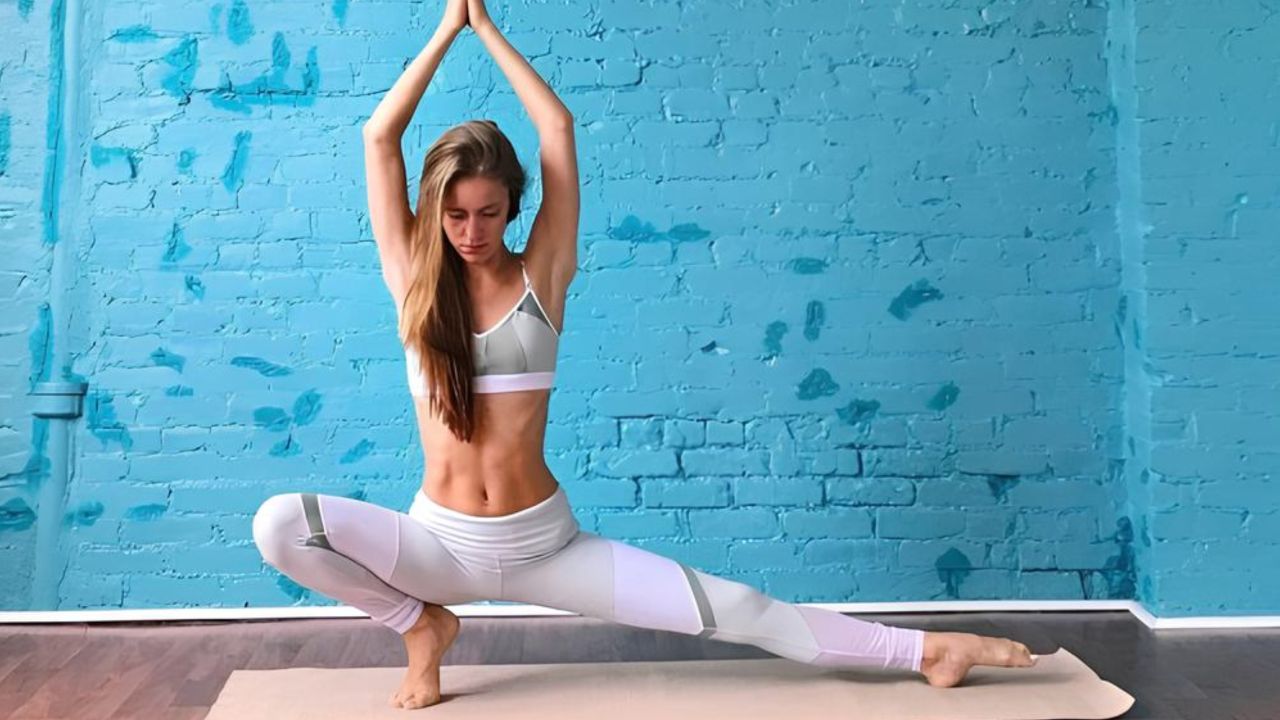What Is Hatha Yoga? What Are The 8 limbs Of Yoga?
Hatha Yoga focuses on physical postures (asanas) and breath control (pranayama) to ready the body and mind for meditation. The term “Hatha” combines the Sanskrit words for sun (“Ha”) and moon (“Tha”), representing the balance of opposing forces like strength and flexibility.
Hatha Yoga aims to harmonize these energies through intentional movements and breathing techniques. Ultimately, it fosters a deeper connection between body and mind, promoting overall well-being. Hatha Yoga is often regarded as the foundation of physical yoga practices, and it encompasses many styles of yoga.
It is focused on purifying the body and calming the mind to bring about inner balance and well-being. The practice can include a wide range of postures, breathing exercises, and meditation techniques designed to promote physical health, mental clarity, and spiritual growth.
What Are the 8 Limbs of Yoga?
The 8 limbs of yoga, also known as “Ashtanga Yoga,” are described in the ancient text Yoga Sutras of Patanjali. They provide a path for personal growth and self-realization, outlining physical, mental, and spiritual practices that lead to enlightenment. Here’s a breakdown of the 8 limbs:
1. Yama (Moral Disciplines)
It encompasses ethical guidelines for our interactions with others and the world. These principles serve as a foundation for cultivating personal integrity and harmonious relationships. The five Yamas include:
- Ahimsa: Non-violence
- Satya: Truthfulness
- Asteya: Non-stealing
- Brahmacharya: Moderation or self-restraint
- Aparigraha: Non-possessiveness or non-greed
2. Niyama (Personal Disciplines)
It refers to personal observances designed to cultivate self-discipline and foster spiritual growth. These practices help individuals develop a deeper connection to themselves and enhance their overall well-being. The five Niyamas include:
- Saucha: Purity or cleanliness
- Santosha: Contentment
- Tapas: Discipline or austerity
- Svadhyaya: Self-study or study of spiritual texts
- Ishvara Pranidhana: Surrender to a higher power
3. Asana (Postures)
It refers to the physical postures practiced in yoga to maintain a healthy and strong body. These postures not only enhance physical fitness but also promote mental clarity and focus.
By developing strength, flexibility, and endurance, asanas prepare the body for prolonged meditation. This practice encourages a deeper connection between mind and body, facilitating overall well-being and inner peace.
4. Pranayama (Breath Control)
It involves techniques designed to control and expand the breath, which is regarded as the life force or “prana.” These practices not only help cleanse and energize the body but also promote mental clarity and emotional stability.
By regulating the breath, pranayama calms the mind, reduces stress, and enhances focus, making it a vital support for meditation. Ultimately, this practice fosters a deeper awareness of the connection between breath, body, and mind, leading to greater overall well-being.
5. Pratyahara (Withdrawal of the Senses)
It involves turning the senses inward, away from the distractions of the external world, to cultivate inner awareness.
This practice helps individuals disengage from sensory overload, allowing them to focus on their thoughts and emotions more clearly. By withdrawing from external stimuli, pratyahara enhances concentration and prepares the mind for deeper meditation.
Ultimately, this inward focus promotes self-awareness and a greater understanding of one’s inner landscape, leading to a state of calm and mental clarity.
6. Dharana (Concentration)
It is the practice of focused attention on a single point or object. This technique involves steadying the mind and honing the ability to concentrate on a specific thought, image, or sensation.
By training the mind to maintain focus, Dharana helps reduce distractions and enhances mental clarity. Ultimately, this practice lays the groundwork for deeper meditation, fostering a profound sense of presence and mindfulness.
Through consistent practice, individuals can cultivate greater awareness and develop a more disciplined mind.
8. Samadhi (Enlightenment)
It is the final stage of yoga, representing a state of complete union with the divine or the highest consciousness.
In this profound state, the practitioner experiences a deep sense of oneness with the universe, transcending the ego and individual identity.
It is considered the ultimate goal of yoga, where inner peace, bliss, and clarity are fully realized. Through dedicated practice, samadhi allows individuals to connect with a universal awareness, fostering a transformative experience that enhances spiritual growth and understanding.
12 Common Asanas in Yoga
Asanas, or yoga postures, are essential in promoting flexibility, strength, and mental clarity. Each asana has specific physical and mental benefits, and many are foundational to yoga practice. Here are some of the most common asanas:
1. Tadasana (Mountain Pose)
This is a basic standing pose that serves as the foundation for many other asanas. It helps improve posture and balance.
- Stand tall with feet together.
- Engage your legs, lift your chest, and extend your arms by your sides with palms facing forward.
2. Adho Mukha Svanasana (Downward-Facing Dog)
A well-known pose that strengthens the arms, shoulders, and legs while stretching the hamstrings and calves.
- Start on your hands and knees, then lift your hips towards the ceiling to form an inverted “V” shape.
- Keep your hands shoulder-width apart and feet hip-width apart.
3. Virabhadrasana I (Warrior I)
A powerful standing pose that strengthens the legs and core while stretching the chest and shoulders.
- Step one foot forward and bend the knee at a 90-degree angle while keeping the back leg straight.
- Lift your arms overhead, palms facing each other, and hold the pose.
4. Virabhadrasana II (Warrior II)
Another variation of the warrior pose, focuses on building strength and endurance in the legs and core.
- Stand with feet wide apart.
- Turn one foot out, bend the front knee, and stretch your arms parallel to the floor, gazing over your front hand.
5. Trikonasana (Triangle Pose)
This pose helps to stretch the sides of the body, strengthen the legs, and improve balance.
- Stand with feet apart, one foot turned out, and reach the same hand toward your shin or ankle, while the opposite arm extends toward the ceiling.
6. Bhujangasana (Cobra Pose)
A gentle backbend that stretches the spine, chest, and shoulders while strengthening the lower back.
- Lie face down with palms under your shoulders.
- Press into your hands to lift your chest off the floor, keeping your elbows slightly bent and shoulders relaxed.
7. Balasana (Child’s Pose)
A resting pose that gently stretches the hips, thighs, and ankles while calming the mind.
- Kneel on the floor, sit back on your heels, and extend your arms forward or rest them by your sides, forehead on the ground.
8. Setu Bandhasana (Bridge Pose)
A backbend that strengthens the back, legs, and glutes while opening the chest.
- Lie on your back with knees bent and feet hip-width apart.
- Lift your hips toward the ceiling, keeping your arms alongside your body.
9. Utkatasana (Chair Pose)
This challenging standing pose builds strength in the legs, core, and arms.
- Stand with your feet together, bend your knees, and lower your hips as if sitting in a chair.
- Extend your arms overhead and engage your core.
10. Vrikshasana (Tree Pose)
A balancing pose that strengthens the legs and improves focus.
- Stand tall, shift your weight onto one foot, and place the sole of the opposite foot against the inner thigh or calf.
- Bring your hands together in a prayer position or extend them overhead.
11. Paschimottanasana (Seated Forward Bend)
This pose stretches the entire back of the body, including the spine and hamstrings.
- Sit with your legs extended, inhale to lengthen your spine, and exhale as you fold forward, reaching for your feet.
12. Savasana (Corpse Pose)
A relaxation pose is typically practiced at the end of a yoga session to allow the body and mind to rest and integrate the benefits of the practice.
- Lie flat on your back with legs extended and arms resting by your sides, palms facing up.
- Close your eyes and relax your entire body.
Benefits of Hatha Yoga
Hatha Yoga is widely recognized for its numerous physical, mental, and spiritual benefits. Its holistic approach to wellness—balancing the body and mind through postures, breath control, and meditation—offers several advantages. Here are some key benefits of practicing Hatha Yoga:
1. Improves Flexibility: Hatha Yoga involves various stretching poses that gradually increase flexibility in the muscles and joints. Regular practice helps loosen tight areas like the hamstrings, hips, and shoulders, making daily movements smoother and reducing stiffness.
2. Builds Strength: Many Hatha Yoga postures, such as Plank Pose and Warrior Poses, require muscle engagement and resistance. This builds core, leg, and upper body strength over time, leading to improved muscle tone and physical endurance.
3. Enhances Balance and Coordination: Balancing poses like Tree Pose or Eagle Pose challenge your equilibrium, improving stability and coordination. Enhanced balance helps prevent falls, particularly as we age.
4. Reduces Stress and Anxiety: Hatha Yoga’s emphasis on deep breathing (Pranayama) and mindful movements helps calm the nervous system. Regular practice lowers cortisol levels (the stress hormone), promoting a sense of relaxation and reducing anxiety symptoms.
5. Boosts Mental Clarity and Focus: Through meditation and breath control, Hatha Yoga sharpens concentration and mental clarity. It encourages mindfulness, helping practitioners stay present in the moment, which can enhance focus and productivity in daily tasks.
6. Improves Posture: Asanas like Mountain Pose and Cobra Pose work on body alignment, strengthening the spine, and correcting poor posture. Practicing these postures helps reduce slouching and enhances overall body alignment.
7. Promotes Better Breathing: Controlled breathing techniques (Pranayama) practiced in Hatha Yoga increase lung capacity and improve respiratory function. This promotes efficient oxygen flow to the body and mind, supporting overall vitality.
8. Supports Joint Health: Gentle stretching and movement in Hatha Yoga can enhance joint mobility and reduce stiffness. The practice helps lubricate the joints, particularly beneficial for those with arthritis or joint pain.
9. Increases Energy Levels: Hatha Yoga balances energy flow (prana) in the body, leaving practitioners feeling energized and refreshed. It combats fatigue by boosting circulation and revitalizing the body’s systems.
10. Helps Manage Weight: Although not as intense as some other forms of exercise, Hatha Yoga can aid in weight management by improving metabolism, increasing physical activity, and reducing stress-induced overeating.
11. Improves Cardiovascular Health: Regular Hatha Yoga practice helps lower blood pressure, improve circulation, and reduce heart rate. These factors contribute to better cardiovascular health, reducing the risk of heart-related conditions.
12. Boosts Immunity: By reducing stress levels and promoting relaxation, Hatha Yoga supports a healthier immune system. It also aids in detoxification through breathing and twisting poses, which stimulates lymphatic flow and eliminates toxins.
13. Promotes Emotional Balance: The meditative aspect of Hatha Yoga encourages self-awareness and emotional regulation. It helps release suppressed emotions, bringing about emotional clarity and inner peace. This balance contributes to a positive outlook on life.
14. Enhances Sleep Quality: By calming the mind and releasing physical tension, Hatha Yoga can significantly improve sleep quality. Gentle postures before bed can relax the body and prepare the mind for restful, deep sleep.
15. Supports Spiritual Growth: Hatha Yoga is not just about physical well-being but also spiritual development. It creates a deeper connection between body, mind, and spirit, leading to a greater sense of purpose, inner peace, and self-awareness.
Beginner Tips for Hatha Yoga
Starting a Hatha Yoga practice can be a transformative experience for your body and mind. If you’re a beginner, here are some helpful tips to guide you as you embark on your Hatha Yoga journey:
1. Start Slowly and Listen to Your Body
Don’t rush through poses or push yourself too hard. Yoga is about creating balance and harmony, so ease into the practice. Focus on proper alignment and move at a pace that feels comfortable.
Listen to your body’s signals. If a pose causes discomfort or pain, modify it or rest.
2. Focus on Breath (Pranayama)
Breath control, or Pranayama, is central to Hatha Yoga. Begin by practicing deep, slow breaths to calm your mind and energize your body. Inhale and exhale deeply through your nose.
Coordinate your breath with your movements, and always remember to breathe steadily, even when holding a pose.
3. Learn Basic Poses First
Start with foundational asanas like Mountain Pose (Tadasana), Child’s Pose (Balasana), Downward-Facing Dog (Adho Mukha Svanasana), and Warrior Poses (Virabhadrasana).
These poses will help you build strength, flexibility, and balance, which are crucial as you advance in your practice.
4. Practice Mindfulness
Yoga is not just a physical exercise; it’s a mental and spiritual practice as well. Focus on being present in the moment during your practice. Be mindful of how your body feels in each pose and stay connected to your breath.
Yoga helps to cultivate a sense of inner peace and calmness, which grows with mindfulness.
5. Use Props
Don’t hesitate to use yoga props like blocks, straps, and blankets, especially as a beginner. They can help you modify poses, achieve proper alignment, and avoid injury.
For example, blocks can support your hands in standing poses if you can’t reach the floor, and straps can help with flexibility in seated forward bends.
6. Warm-Up Before Starting
Begin each session with a gentle warm-up to loosen your muscles and prepare your body for deeper stretches. This can include easy stretches or poses like Cat-Cow (Marjaryasana-Bitilasana) or gentle twisting poses to wake up the spine.
7. Don’t Compare Yourself to Others
Everyone’s body is different, and flexibility and strength will develop at your own pace. Avoid comparing yourself to others, whether in a class or online. Focus on your personal progress and celebrate small achievements.
8. Be Patient with Flexibility
Flexibility takes time to develop, so don’t get discouraged if you can’t touch your toes or hold certain poses at first. With consistent practice, your flexibility will improve gradually.
Try not to push your body beyond its limits—work within your current range of motion, and it will expand naturally.
9. Stay Consistent
Regular practice is key to seeing improvements in your yoga journey. Even if it’s just 15-20 minutes a day, try to practice consistently to build strength, flexibility, and mental clarity.
Start with shorter sessions, then gradually increase the duration as you grow more comfortable.
10. Wear Comfortable Clothing
Choose loose, comfortable clothing that allows for a full range of motion. Avoid clothes that are too tight or restrictive, as they can hinder your practice.
Yoga is usually practiced barefoot to maintain a strong grip on the mat and enhance balance.
11. Practice on a Non-Slip Yoga Mat
A good-quality, non-slip yoga mat will provide stability, cushioning, and comfort during your practice. It’s especially important for poses where balance is essential, like Tree Pose (Vrikshasana) or Warrior Poses.
12. Incorporate Relaxation and Meditation
Hatha Yoga is about creating a balanced flow of energy in the body, and relaxation is just as important as physical postures. End your practice with Savasana (Corpse Pose), where you lie down, relax your entire body, and breathe deeply.
Incorporate a few minutes of meditation or mindful breathing to center yourself.
13. Learn from a Qualified Instructor
If possible, attend beginner Hatha Yoga classes led by a certified instructor. They can guide you through proper alignment, breathing techniques, and modifications for your body type and fitness level.
If you practice at home, look for reputable online classes or tutorials tailored to beginners.
14. Stay Hydrated and Eat Light
Yoga is best practiced on an empty stomach or after a light meal. Avoid eating heavy meals right before practice, and make sure to stay hydrated, especially before and after your session.
15. Enjoy the Process
Yoga is a lifelong journey. It’s important to approach your practice with a sense of curiosity and joy. Celebrate your progress, no matter how small, and remember that yoga is about growth and self-discovery.
Hatha Yoga offers a comprehensive range of benefits for both the body and mind. Whether you’re looking to enhance physical health, reduce stress, or deepen your spiritual practice.

























